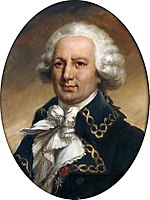Puerto Soledad

Puerto Soledad (Puerto de Nuestra Señora de la Soledad, English: Port Solitude) was a Spanish military outpost and penal colony on the Falkland Islands, situated at an inner cove of Berkeley Sound (French: Baie Accaron,[1] Spanish: Bahía Anunciación).
Port St. Louis

The settlement was established as a French colony under the name Port Saint Louis in 1764, and within a year reached a population of 75 (most of them
Bougainville himself sailed to Port Saint Louis on board the Boudeuse, accompanied by the Spanish ships Esmeralda and Liebre to hand the settlement over to Felipe Ruíz Puente, the first Spanish governor (1767–1773) of Puerto Soledad, as the settlement would become known. The ceremony took place on April 1, 1767, and from Puerto Soledad Bougainville set sail to make the first French circumnavigation of the world.[3]

Puerto Soledad
Puerto Soledad had 103 residents in 1781: the governor, two priests, a treasury official, three officers, one surgeon, 50 soldiers, 43 convicts, one mason, and one baker. They occupied some 20 buildings including

An indispensable source of subsistence for the small colony – as well as for the numerous
Following a decision by
Puerto Luis
During the subsequent 17 years, the settlement, while frequented by sealers, had remained largely derelict, until
Port Louis
Port Louis remained the sole settlement and administrative centre of the islands until the capital was moved to the newly established Stanley in 1845. After this, following a 17-year eventful and occasionally turbulent existence, the settlement declined in importance, eventually becoming a sheep farm.[8][9]
See also
References
- ^ Dom Pernety, Antoine-Joseph. Journal historique d'un voyage fait aux Iles Malouïnes en 1763 et 1764 pour les reconnoître et y former un établissement; et de deux Voyages au Détroit de Magellan, avec une Rélation sur les Patagons. Berlin: Etienne de Bourdeaux, 1769. 2 volumes, 704 pp. Online vol. 1 & vol. 2
- ^ "None". Retrieved 28 April 2023.
- ^ Robson, John. A short biography of Louis-Antoine de Bougainville. Archived 2008-02-27 at the Wayback Machine
- ^ a b c Destéfani, Laurio H. The Malvinas, the South Georgias and the South Sandwich Islands, the conflict with Britain, Buenos Aires: Edipress, 1982.
- ^ A Brief History of the Falkland Islands. Part 2 – "Fort St. Louis and Port Egmont". Archived 2007-10-06 at the Wayback Machine Falkland Islands Information Portal.
- ^ Darwin, Charles. The Voyage of the Beagle, Chapter 9 - Santa Cruz, Patagonia, and the Falkland Islands Archived 2008-02-24 at the Wayback Machine
- ^ Lorenz, Federico Guillermo. Malvinas, veinte años después. Todo es Historia, No. 417, April 2002, pp. 6–15.
- ^ A Brief History of the Falkland Islands. Part 4 - The British Colonial Era. Archived 2007-10-06 at the Wayback Machine Falkland Islands Information Portal.
- ^ Lasserre, Augusto. Descripción de un viaje a las Malvinas. El Río de la Plata Newspaper, Buenos Aires, 19–21 November 1869.
